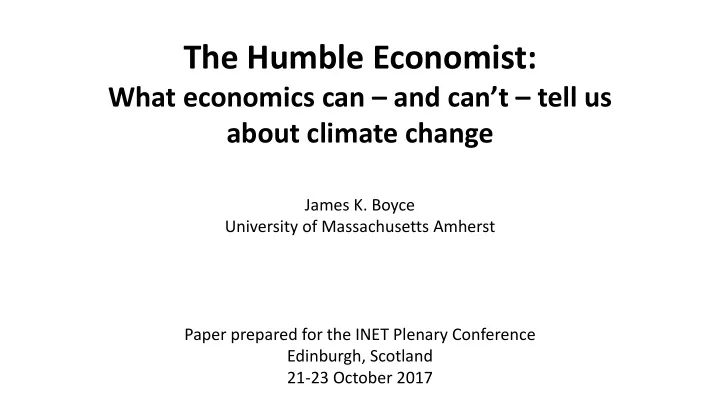

The Humble Economist: What economics can – and can’t – tell us about climate change James K. Boyce University of Massachusetts Amherst Paper prepared for the INET Plenary Conference Edinburgh, Scotland 21-23 October 2017
Carbon price paths DICE optimum vs. 2.5 ° C maximum $1,100 $1,006.20 $1,000 $900 $800 SCC ($/ton CO 2 ) $700 $600 $500 $351.00 $400 $284.10 $229.10 $300 $200 $103.60 $51.20 $43.50 $100 $36.70 $0 2020 2025 2030 2035 2040 2045 2050 Year Welfare Optimizing 2.5 Degree Maximum Global CO2 price in 2010 US dollars. Data from Nordhaus (2017a), Table 1.
Temperature paths Notes: Base = business-as-usual scenario (no climate policy); Opt = cost-benefit economic optimum from DICE model; T<2.5 = path that limited global mean temperature increase to 2.5 °C; Stern = policy with low discount rate recommended by Stern Review (2007). Source: Nordhaus (2017b), Figure 4.
Marginal Costs of Emission Reduction Options Source: McKinsey & Company (2009) Pathways to a Low-Carbon Economy: Version 2 of the Global Greenhouse Gas Abatement Cost Curve.
Frequency distribution of estimated long-run price elasticities of demand for energy Note: Distribution of 959 estimated long-run price elasticities of demand obtained from multiple studies. Source: Labandeira et al . (2017), Fig. 1.
Incidence of $200/t CO2 tax in U.S. 14.0% 12.5% 11.4% 12.0% 10.6% 10.0% Carbon tax as percentage of 10.0% 8.7% household expenditure 8.0% 6.0% 4.0% 2.0% 0.0% 1 2 3 4 5 Household expenditure quintile Note: Based on consumer expenditure survey data for 2012-2014. Quintiles based on equivalent household expenditures using the square root scale, where equivalent household expenditures = household expenditures/(household size^1/2). Source: Calculated from data presented in Fremstad and Paul (2017), Table 10.
Net incidence of $200/t CO2 tax coupled with dividends in U.S. 25.0% 20.4% Net transfer with dividends, as percentage of 20.0% household expenditure 15.0% 10.0% 7.9% 5.0% 3.0% 0.7% 0.0% -3.0% -5.0% 1 2 3 4 5 Household expenditure quintile Source: Calculated from data presented in Fremstad and Paul (2017), Table 10.
Percentage of individuals receiving positive net transfers from $200/t CO2 tax coupled with dividends in U.S. 100% 88% Percentage of individuals receiving positive net 90% 77% 80% 65% 70% 60% 50% transfer 50% 40% 28% 30% 20% 10% 0% 1 2 3 4 5 Household expenditure quintile Source: Calculated from data presented in Fremstad and Paul (2017), Table 10.
Recommend
More recommend